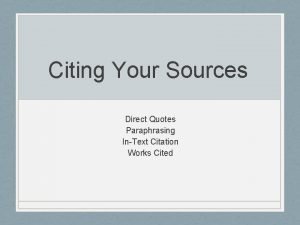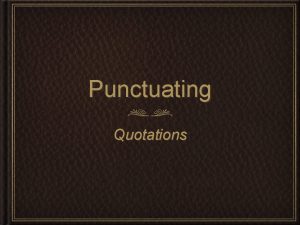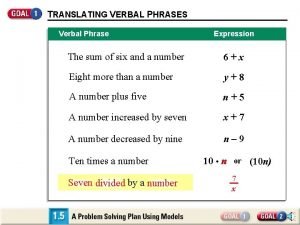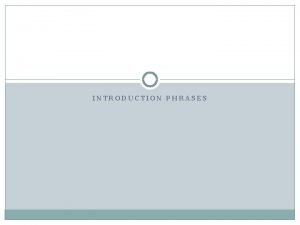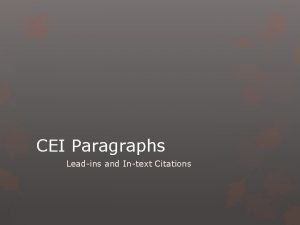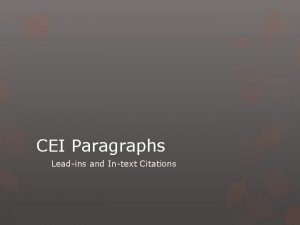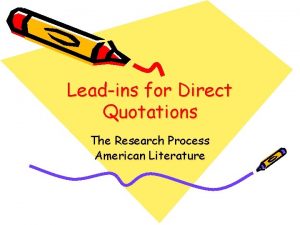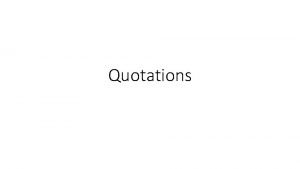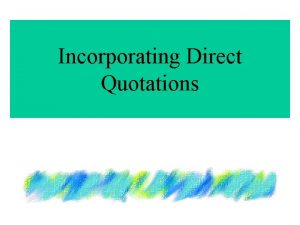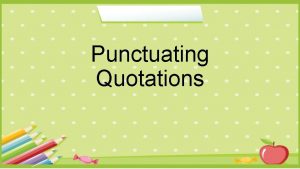Leadins and Signal Phrases Using Direct Quotations What










- Slides: 10

Lead-ins and Signal Phrases Using Direct Quotations

What are Lead-Ins? Lead-ins, also called signal phrases and tag lines, introduce direct quotations in a research paper. u They can appear at the beginning, in the middle, or at the end of the direct quotation from an outside source. u They are generally set off with a comma or commas depending upon their location in the sentence. u

Parenthetical/In-text Citations These citations indicate the source of the direct quotation. u They appear inside parentheses at the end of the borrowed material. u They include the source’s author’s last name and page number(s). u If there is no author, then they use the article title inside quotation marks and the page number(s). u

Parnethetical/In-Text Citations (cont’d. ) u Place a period after the last parenthesis to indicate the end of the sentence. u The exception to this punctuation placement is in the longer block indented quotation in which the period is placed BEFORE the parentheses.

1. Samples of Lead-ins u According to Jane Doe, “. . . ” (#). u In the words of researcher Jane Doe, “. . . ” (#). u As biologist Jane Doe puts it, “. . . ” (#). u Jane Doe points out that “. . . ” (#) # = page number(s) on which the source material can be found

2. Samples of Lead-ins u Jane Doe, well-known scientist, argues that “. . . ” (#). u Jane Doe, a professor at X University, admits that “. . . ” (#). u Jane Doe has concluded that “. . . ” (#). u Jane Doe reports that “. . . ” (#). u Jane Doe writes that “. . . ” (#).

3. Samples of Lead-ins u Jane Doe stated in an interview that “. . . ” (#). u “. . . , ” remarks Jane Doe, “. . . ” (#). u “. . . , ” claims attorney Jane Doe (#). u Jane Doe offers an intriguing argument for this view: “. . . ” (#).

Block indented quotations u Jane Doe’s conclusions are somewhat questionable. Consider, for example, the following passage: Blah blah blah blah blah blah blah blah blah. (23 -24)

Some Exceptions For INTERNET SOURCES u It is not necessary to list any page numbers for electronic sources including databases and web pages. u Use only the author’s last name or article title inside quotation marks.

CREDITS Prepared for ENG 101, ENG 102, and ENG 109 u Sarah Dye, Professor u March 2004 u
 What is the purpose of a signal phrase
What is the purpose of a signal phrase Direct and indirect quotations
Direct and indirect quotations Dr. xiaorong you
Dr. xiaorong you Sandwich sorcerer
Sandwich sorcerer Put around a speaker's exact words
Put around a speaker's exact words Baseband signal and bandpass signal
Baseband signal and bandpass signal Baseband signal and bandpass signal
Baseband signal and bandpass signal What is the product of an even signal and odd signal
What is the product of an even signal and odd signal Verbal phrases to mathematical phrases examples
Verbal phrases to mathematical phrases examples Direct quote
Direct quote Signal phrases to introduce quotes
Signal phrases to introduce quotes



